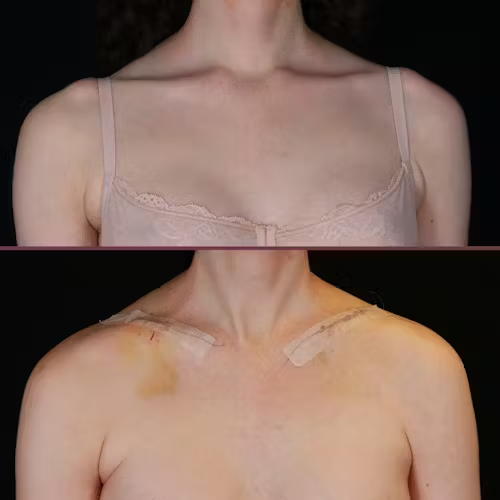Clavicle shortening surgery, often pursued by patients seeking a more defined collarbone or addressing specific medical conditions, has gained popularity as an aesthetic and corrective procedure. While this surgery can offer remarkable results, it’s essential for potential candidates to understand the possible complications that may arise.

In this article, we will explore the potential risks and complications associated with clavicle shortening surgery, providing valuable insights to help you make an informed decision.
Infection Risk
As with any surgical procedure, infection is one of the most common complications. Although rare, it can occur if the surgical site becomes contaminated by bacteria. Signs of infection include redness, swelling, increased pain, and fever.
Prevention:
- Proper aftercare, including keeping the wound clean and dry.
- Following the surgeon’s post-operative instructions closely.
- Taking prescribed antibiotics as directed.
Nerve Damage
During clavicle shortening surgery, there is a risk of nerve damage, particularly to the brachial plexus, a group of nerves that control the arm. If the nerves are stretched or compressed during the surgery, it can lead to numbness, weakness, or even paralysis in the arm or hand.
Prevention:
- Choose a skilled and experienced surgeon who is well-versed in the anatomy of the collarbone and surrounding structures.
- Discuss any concerns with your surgeon before the procedure to ensure proper techniques are used.
Scarring
Scarring is inevitable with any surgery, and clavicle shortening is no exception. While most scars are minimal and fade over time, some individuals may experience hypertrophic or keloid scarring, which can be more noticeable and may require additional treatments.
Prevention:
- Follow post-operative care instructions to minimize scarring.
- Apply silicone-based gels or ointments as recommended by your surgeon.
- Consider laser treatments or steroid injections if scars become problematic.
Bone Healing Complications
In some cases, the clavicle may not heal properly following surgery. This can lead to non-union (when the bone does not heal) or malunion (when the bone heals in an improper position). These complications may require additional surgeries or extended recovery times.
Prevention:
- Adhere to weight-bearing restrictions and avoid strenuous activities during the recovery period.
- Regular follow-up appointments with your surgeon to monitor bone healing progress.
Blood Clots
Blood clots, particularly deep vein thrombosis (DVT), can occur after any surgery, including clavicle shortening. A clot can form in the veins, usually in the legs, and if it travels to the lungs, it can cause a pulmonary embolism, which is life-threatening.
Prevention:
- Follow your surgeon’s advice on movement and physical activity during recovery.
- Use compression stockings if recommended.
- Stay hydrated and consider blood thinners if prescribed.
Asymmetry or Unwanted Aesthetic Outcomes
Although the goal of clavicle shortening surgery is typically aesthetic, there is always a risk that the results may not meet the patient’s expectations. Asymmetry or an unsatisfactory aesthetic outcome can occur, which may lead to the need for revision surgery.
Prevention:
- Have realistic expectations and a thorough consultation with your surgeon about what can and cannot be achieved with the surgery.
- Consider all aspects of the procedure, including recovery time and long-term results.
Shoulder and Arm Mobility Issues
After clavicle shortening surgery, some patients may experience stiffness or limited range of motion in the shoulder and arm. This can result from muscle tightness or scar tissue formation around the surgical site.
Prevention:
- Engage in physical therapy and rehabilitation to improve mobility and prevent stiffness.
- Follow the exercise regimen suggested by your surgeon to regain full shoulder function.
Post-Surgical Pain
Pain is a normal part of any surgery, and clavicle shortening is no exception. However, in some cases, patients may experience chronic pain after the procedure, which can affect the quality of life.
Prevention:
- Use pain management strategies prescribed by your surgeon.
- Gradually resume activities as advised, avoiding overexertion that could cause excessive pain.
Anesthesia Risks
General anesthesia, commonly used during clavicle shortening surgery, carries its own set of risks, such as allergic reactions or complications related to pre-existing health conditions like heart disease.
Prevention:
- Provide your anesthesiologist with a full medical history prior to surgery.
- Follow all pre-operative instructions, including fasting and medication adjustments.
Psychological Impact
Undergoing cosmetic surgery can have psychological consequences, particularly if the results are not as expected or if complications arise during recovery. Patients may experience stress, anxiety, or even depression related to their surgery and recovery process.
Prevention:
- Seek psychological counseling if needed before and after surgery.
- Ensure that you are emotionally prepared for the recovery process and any potential challenges.
Conclusion
Clavicle shortening surgery is an effective way to achieve aesthetic goals, but it is not without risks. Understanding the potential complications is crucial for making an informed decision about whether or not this procedure is right for you.

By carefully selecting an experienced surgeon, following post-operative instructions, and managing your recovery well, you can minimize the risks associated with clavicle shortening surgery. Always remember to prioritize both your physical and emotional well-being throughout the entire process.
Contact Cayra Clinic for More Information
If you are considering clavicle shortening surgery or have any further questions, don’t hesitate to get in touch with Cayra Clinic for a detailed consultation. Our expert surgeons are dedicated to providing you with the best possible care. You can also visit our about us page and our services page to know more about us and our services.
